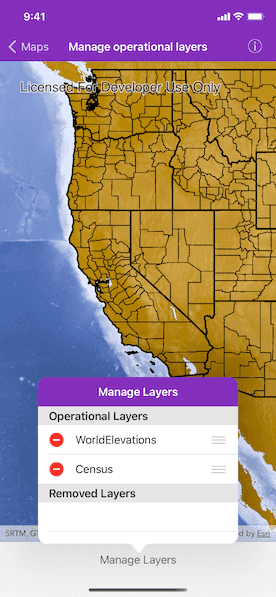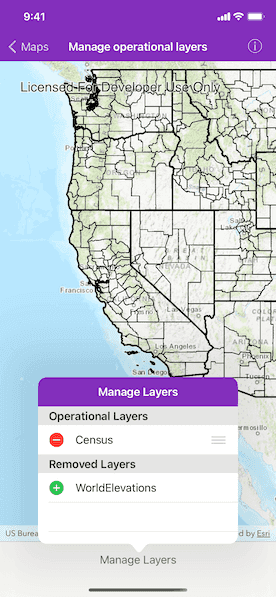Add, remove, and reorder operational layers in a map.


Use case
Operational layers display the primary content of the map and usually provide dynamic content for the user to interact with (as opposed to basemap layers that provide context).
The order of operational layers in a map determines the visual hierarchy of layers in the view. You can bring attention to a specific layer by rendering above other layers.
How to use the sample
Tap the toolbar button to display the operational layers that are currently displayed in the map. In the first section, tap "-" button to remove a layer, or tap and hold the reordering control and drag to reorder a layer. The map will be updated automatically.
The second section shows layers that have been removed from the map. Tap one to add it back to the map.
How it works
- Get the operational layers from the map's
operationalLayersproperty. - Add or remove layers by modifying the
operationalLayersarray. The last layer in the array will be rendered on top.
Relevant API
- AGSLayer
- AGSMap
Additional information
You cannot add the same layer to the map multiple times or add the same layer to multiple maps. Instead, clone the layer using AGSLayer.copy() to create a new instance.
Tags
add, delete, layer, map, remove
Sample Code
// Copyright 2016 Esri.
//
// Licensed under the Apache License, Version 2.0 (the "License");
// you may not use this file except in compliance with the License.
// You may obtain a copy of the License at
//
// http://www.apache.org/licenses/LICENSE-2.0
//
// Unless required by applicable law or agreed to in writing, software
// distributed under the License is distributed on an "AS IS" BASIS,
// WITHOUT WARRANTIES OR CONDITIONS OF ANY KIND, either express or implied.
// See the License for the specific language governing permissions and
// limitations under the License.
import UIKit
import ArcGIS
class MMLLayersViewController: UITableViewController {
/// The map for which to manage the operational layers.
weak var map: AGSMap?
/// Every layer on the map or that could be added to the map.
var allLayers: [AGSLayer] = []
/// The layers present in `allLayers` but not in the map's `operationalLayers`.
private var removedLayers: [AGSLayer] {
if let operationalLayers = map?.operationalLayers as? [AGSLayer] {
return allLayers.filter { !operationalLayers.contains($0) }
}
return []
}
override func viewDidLoad() {
super.viewDidLoad()
// enable the editing UI
tableView.isEditing = true
}
/// A convenience type for the table view sections.
private enum Section: CaseIterable {
case operational, removed
var label: String {
switch self {
case .operational:
return "Operational Layers"
case .removed:
return "Removed Layers"
}
}
}
// MARK: - UITableViewDataSource
override func numberOfSections(in tableView: UITableView) -> Int {
return Section.allCases.count
}
override func tableView(_ tableView: UITableView, numberOfRowsInSection section: Int) -> Int {
switch Section.allCases[section] {
case .operational:
return map?.operationalLayers.count ?? 0
case .removed:
return removedLayers.count
}
}
override func tableView(_ tableView: UITableView, titleForHeaderInSection section: Int) -> String? {
return Section.allCases[section].label
}
override func tableView(_ tableView: UITableView, cellForRowAt indexPath: IndexPath) -> UITableViewCell {
let cell = tableView.dequeueReusableCell(withIdentifier: "LayerCell", for: indexPath)
let layerForIndexPath: AGSLayer? = {
switch Section.allCases[indexPath.section] {
case .operational:
return map?.operationalLayers.object(at: indexPath.row) as? AGSLayer
case .removed:
return removedLayers[indexPath.row]
}
}()
cell.textLabel?.text = layerForIndexPath?.name
return cell
}
// MARK: - UITableViewDelegate
override func tableView(_ tableView: UITableView, editingStyleForRowAt indexPath: IndexPath) -> UITableViewCell.EditingStyle {
switch Section.allCases[indexPath.section] {
case .operational:
return .delete
case .removed:
return .insert
}
}
override func tableView(_ tableView: UITableView, canMoveRowAt indexPath: IndexPath) -> Bool {
return Section.allCases[indexPath.section] == .operational
}
override func tableView(_ tableView: UITableView, targetIndexPathForMoveFromRowAt sourceIndexPath: IndexPath, toProposedIndexPath proposedDestinationIndexPath: IndexPath) -> IndexPath {
if Section.allCases[sourceIndexPath.section] == .operational,
Section.allCases[proposedDestinationIndexPath.section] == .operational {
// only allow reordering within the operational layers section
return proposedDestinationIndexPath
}
return sourceIndexPath
}
override func tableView(_ tableView: UITableView, moveRowAt sourceIndexPath: IndexPath, to destinationIndexPath: IndexPath) {
// update the order of layers in the array
if destinationIndexPath != sourceIndexPath {
map?.operationalLayers.exchangeObject(at: sourceIndexPath.row, withObjectAt: destinationIndexPath.row)
}
}
override func tableView(_ tableView: UITableView, commit editingStyle: UITableViewCell.EditingStyle, forRowAt indexPath: IndexPath) {
switch editingStyle {
case .delete:
// move the layer from the operational layers to the removed layers
guard let layerToRemove = map?.operationalLayers.object(at: indexPath.row) as? AGSLayer else {
return
}
map?.operationalLayers.removeObject(at: indexPath.row)
// update the table
tableView.performBatchUpdates({
// delete the row
tableView.deleteRows(at: [indexPath], with: .automatic)
let newIndexPath = IndexPath(row: removedLayers.firstIndex(of: layerToRemove)!, section: 1)
// insert the new row
tableView.insertRows(at: [newIndexPath], with: .fade)
})
case .insert:
// move the layer from the removed layers to the operational layers
let layer = removedLayers[indexPath.row]
map?.operationalLayers.insert(layer, at: 0)
// update the table
tableView.performBatchUpdates({
// delete the row
tableView.deleteRows(at: [indexPath], with: .fade)
let newIndexPath = IndexPath(row: 0, section: 0)
// insert the new row
tableView.insertRows(at: [newIndexPath], with: .fade)
})
case .none:
break
@unknown default:
break
}
}
}